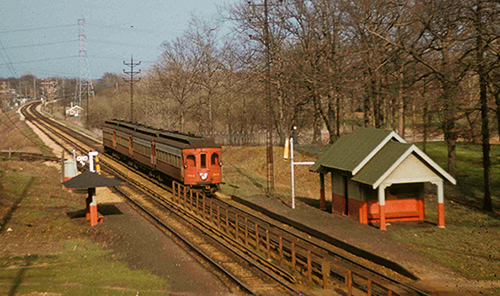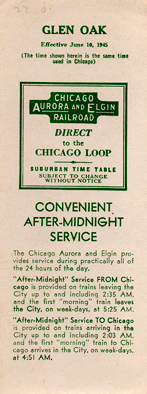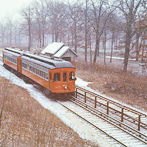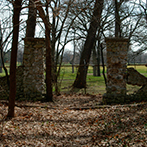
Photo by TH Desnoyers, from the Krambles-Peterson Archive
Glen Oak
Hill Avenue, Village of Glen Ellyn
- Address: TBD
- Established: TBD
- Original Line: Aurora, Elgin & Chicago Ry
- Rebuilt: TBD
- Previous Names: Pickwick
- Flag stop
- (View location)
History:
Glen Oak was a local station on the Chicago, Aurora & Elgin’s main line near Hill Avenue in what is now Glen Ellyn. A stop at this location was not part of the Aurora, Elgin and Chicago Railway’s initial scheme for stations.1
On January 7, 1909, the Pickwick Country Club was founded and established a nine-hole golf course on the site of the McGarry farm,2 which was on a tract of land just south of the Aurora, Elgin and Chicago Railroad’s right of way. Later that year, Pickwick went into bankruptcy which was followed by receivership in 1910. After falling into receivership, the original owners of the Pickwick Country Club repurchased the land and incorporated the Glen Oak County Club on January 17, 1911.3 The station was likely added around this time in order to serve the patrons of the fledgling country club. (A station serving a similar purpose on the Aurora branch was in operation for almost eleven years at this point.)
The station consisted of two low level platforms situated east of the Hill Avenue overpass.4 Attached to the eastbound platform was a 37 ft. 3 in. by 10 ft. 8 in. waiting shelter. This was a framing and stucco building with concrete foundation walls and floor.5 Though the design of the shelter was unique, the layout was similar to other stations on the CA&E in that it had an enclosed center portion and open sections on the outer ends. Atop everything was a split level gable roof clad with shingles. The roof over the center section was elevated above that of the outer sections. The westbound platform featured a short wooden canopy with a hipped, shingle roof. As with the shelter, the design for canopy was not used elsewhere on the CA&E.
The platforms were separated by a wooden fence set between the tracks. A gap in the fence and the third rail at the western end of the platforms permitted passage between platforms. This gap was aligned with a short path to the south of the station which passed through a cobblestone entranceway leading to the north side of the club grounds. No connection was provided to Hill Avenue from the platforms.
Glen Oak was a local station and was therefore a flag stop, as were all local stops on the CA&E. Each platform was equipped with a flag stop semaphore which was used to notify the motorman of an oncoming train to stop. People wishing to catch a train pulled a chain which raised the semaphore (the “flag”) into the horizontal position. If the flag was not raised, the train did not stop even if it was listed as a stop for that train on the timetable. A passenger onboard a train wishing to alight here had to notify a conductor of his or her intention to disembark.
With the cutback of service from Wells Street to Forest Park due to the construction of the Congress Street Superhighway [Eisenhower Expressway (I-290)] in 1953, passengers abandoned the CA&E in droves making the financial situation of the railroad untenable. In response, in 1956, the Chicago Transit Authority (CTA) reviewed two similar plans for assuming operation of the line between Forest Park and Wheaton. A/B skip-stop service would have been implemented over the main line under both schemes. One would have used a fleet of 28 rebuilt PCC streetcars which would have operated between Wheaton and Forest Park where transfers to the “L” would be made.6 Glen Oak would have become an “A’ stop.7 The other plan called for using existing CA&E rolling stock and would have provided direct service to the Loop via the Garfield Park/Congress branch, the Paulina Connector, and the Lake Street Elevated.8 Under this plan the Glen Oak stop would have been one of four stations that would have been eliminated.9
Ultimately, neither of these plans came to pass and on July 3, 1957, the Chicago, Aurora & Elgin abandoned its passenger service. Eventually Glen Oak was razed, most likely when the railroad was scrapped in 1961. The most obvious indication that the station existed are the remains of the cobblestone gateway to the country club, though the platforms (which appear as two long mounds flanking the Illinois Prairie Path—which occupies the railroad’s former right of way) still exist, as does the concrete foundation of the station itself.
Full station profile and history coming soon.





